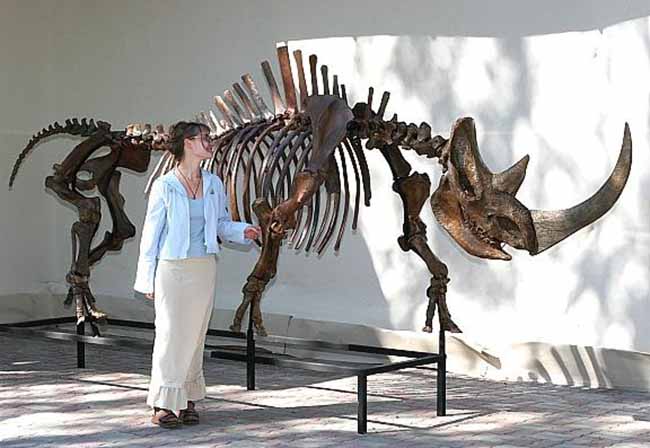

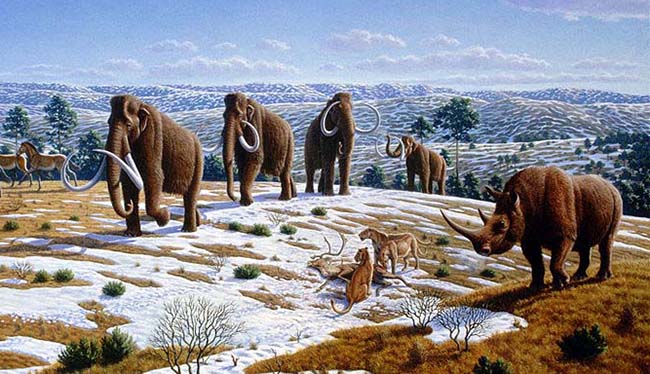
The woolly rhinoceros (Coelodonta antiquitatis) is an extinct species of rhinoceros that was common throughout Europe and northern Asia during the Pleistocene epoch and survived the last glacial period. The genus name Coelodonta means "cavity tooth". The woolly rhinoceros was a member of the Pleistocene megafauna.
As the last and most derived member of the Pleistocene rhinoceros lineage, the woolly rhinoceros was supremely well adapted to its environment. Stocky limbs and thick woolly pelage made it well suited to the steppe-tundra environment prevalent across the Palearctic ecozone during the Pleistocene glaciations. Like the vast majority of rhinoceroses, the body plan of the woolly rhinoceros adhered to a conservative morphology, like the first rhinoceroses seen in the late Eocene. A study of 40-70.000 year old DNA samples showed its closest extant relative is the Sumatran rhinoceros.
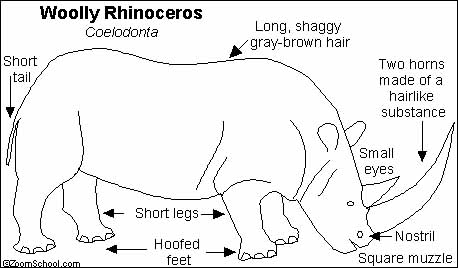
The external appearance of woolly rhinos is known from mummified individuals from Siberia as well as cave paintings. An adult woolly rhinoceros was typically around 3 to 3.8 metres (10 to 12.5 feet) in length, with an estimated weight of around 2,721-3,175 kg (5,999-7,000 lb).
The woolly rhinoceros could grow to be 2 m (6.6 ft) tall; the body size was thus comparable, or slightly larger than, the extant White rhinoceros. Two horns on the skull were made of keratin, the anterior horn being 61 cm (24 in) in length with a smaller horn between its eyes. It had thick, long fur, small ears, short, thick legs, and a stocky body. Cave paintings suggest a wide dark band between the front and hind legs, but the feature is not universal, and identification of pictured rhinoceroses as woolly rhinoceros is uncertain.
Its shape was known only from prehistoric cave drawings until a completely preserved specimen (missing only the fur and hooves) was discovered in a tar pit in Starunia, Poland. The specimen, an adult female, is now on display in the Polish Academy of Sciences' Museum of Natural History in Krakow. Several frozen specimens have also been found in Siberia, the latest in 2007.
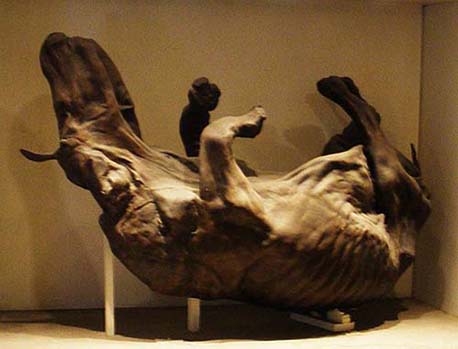
Ahe woolly rhinoceros used its horns for defensive purposes and to attract mates. During Greenland Stadial 2 (the Last Glacial Maximum) the North Sea retreated northward, as sea levels were up to 125 metres (410 ft) lower than today. The woolly rhinoceros roamed the exposed Doggerland and much of Northern Europe and was common in the cold, arid desert that is southern England and the North Sea today. Its geographical range expanded and contracted with the alternating cold and warm cycles, forcing populations to migrate as glaciers receded. The woolly rhinoceros co-existed with woolly mammoths and several other extinct larger mammals of the Pleistocene megafauna. A close relative, Elasmotherium, had a more southern range.
In 2011, the oldest known woolly rhinoceros fossil was discovered from 3.6 million years in the Himalayas on the cold Tibetan Plateau, suggesting it existed there during a period of general climate warmth around the earth. It is believed that they migrated from there to northern Asia and Europe when the Ice Age began.
Females gave birth to one or two calves.
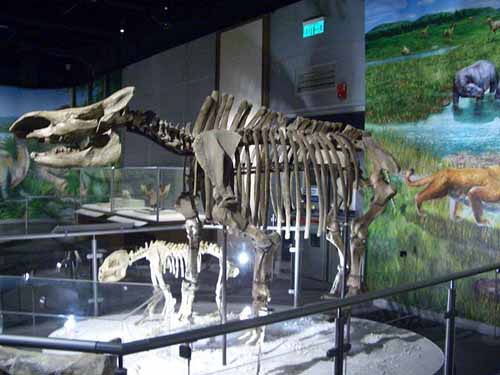
Controversy has long surrounded the precise dietary preference of Coelodonta as past investigations have found both grazing and browsing modes of life to be plausible. The palaeodiet of the woolly rhinoceros has been reconstructed using several lines of evidence. Climatic reconstructions indicate the preferred environment to have been cold and arid steppe-tundra, with large herbivores forming an important part of the feedback cycle. Pollen analysis shows a prevalence of grasses and sedges within a more complicated vegetation mosaic.
A strain vector biomechanical investigation of the skull, mandible and teeth of a well-preserved last cold stage individual recovered from Whitemoor Haye, Staffordshire, revealed musculature and dental characteristics that support a grazing feeding preference. In particular, the enlargement of the temporalis and neck muscles is consistent with that required to resist the large tugging forces generated when taking large mouthfuls of fodder from the ground. The presence of a large diastema supports this theory.
Comparisons with extant perissodactyls confirm that Coelodonta was a hindgut fermentor with a single stomach, and as such would have grazed upon cellulose-rich, protein-poor fodder. This method of digestion would have required a large throughput of food and thus links the large mouthful size to the low nutritive content of the chosen grasses and sedges.
Recent evidence suggests that woolly rhinos alive in the Arctic during the Last Glacial Maximum consumed approximately equal volumes of forbs, such as Artemisia and graminoids.
Many species of Pleistocene megafauna, like the woolly rhinoceros, became extinct around the same time period. Human and Neanderthal hunting is often cited as one cause. Other theories for the cause of the extinctions are climate change associated with the receding Ice age and the hyperdisease hypothesis (q.v. Quaternary extinction event).
Recent radiocarbon dating indicates that populations survived as recently as 8,000 BC in western Siberia. However, the accuracy of this date is uncertain, as several radiocarbon plateaus exist around this time. The extinction does not coincide with the end of the last ice age but does coincide however, with a minor yet severe climatic reversal that lasted for about 1,000-1,250 years, the Younger Dryas (GS1 - Greenland Stadial 1), characterized by glacial readvances and severe cooling globally, a brief interlude in the continuing warming subsequent to the termination of the last major ice age (GS2), thought to have been due to a shutdown of the thermohaline circulation in the ocean due to huge influxes of cold fresh water from the preceding sustained glacial melting during the warmer Interstadial (GI1 - Greenland Interstadial 1 - ca. 16,000 - 11,450 14C years B.P.).
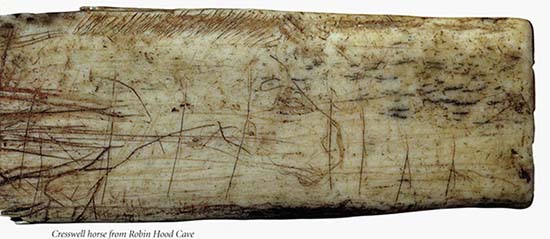
The Pinhole Cave Man is a late Paleolithic figure of a man engraved on a rib bone of the Woolly rhinoceros, found at Creswell Crags in England.
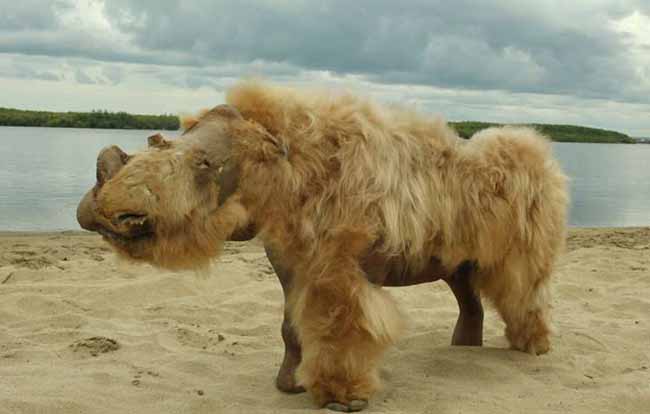
Ancient 'frosty' rhino from Canada's High Arctic rewrites what scientists thought they knew about the North Atlantic Land Bridge Live Science - October 30, 2025
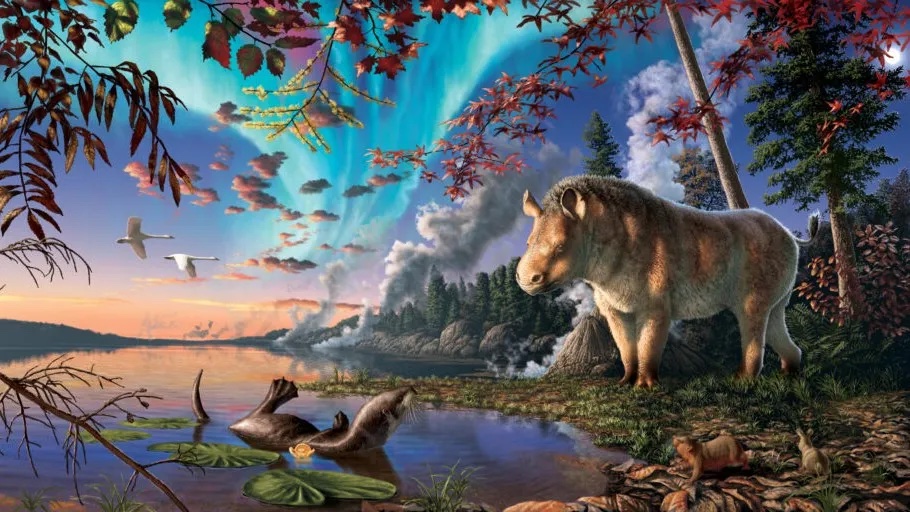
Researchers have gained new insights into rhinoceros evolution and the longevity of the North Atlantic Land Bridge from analyzing the perfectly preserved fossils of a "frosty" Arctic rhino.
Woolly Rhinos Had A Hump On Their Back, Frozen Mummy Reveals IFL Science - November 8, 2024
For the first time ever, researchers have uncovered the mummified remains of a woolly rhinoceros with a big old hump on the back of its neck. Curiously absent in all other known specimens of the Ice Age megafauna, this fatty bulge attests to the remarkable accuracy of ancient cave paintings depicting rhinos with hunched backs.
Intact Skin, Hair, and Tissues Found On 32,400-Year-Old Juvenile Woolly Rhino Mummy IFL Science - September 19, 2024
Russian scientists have recently studied a 32,400-year-old woolly rhinoceros that's been preserved in permafrost like a prehistoric popsicle, revealing a bunch of new insights into the extinct species.
Siberian gold miners accidentally find ancient woolly rhino mummy with horn and soft tissues still intact Live Science - August 7, 2024
The permafrost in Siberia provides ideal conditions for the preservation of ancient creatures. The cold conditions mummify the remains, normally dehydrating soft tissues and locking them away in a frozen "time capsule."
Ice age mammoth, woolly rhino and hyena bones uncovered in English town Live Science - February 9, 2022
The bones of a woolly mammoth, woolly rhinoceros, hyena and wolf recently discovered in an English town are thought to date to the last Ice Age. The animal remains turned up during the construction of a new town called Sherford, which is located in Devon county, near Plymouth, BBC News reported. Construction on the 5,500-home town began in 2015, and the developers called in archaeologists to help with the project from the outset. While excavating a cave in the area, the team discovered the tusk, molar tooth and other bones of a woolly mammoth, as well as the incomplete skull and lower jaw of a woolly rhinoceros
Mouse Study Reveals Previously Unknown Taste Cell That Detects Nearly All Flavors Science Alert - August 13, 2020
The extinction of prehistoric megafauna like the woolly mammoth, cave lion, and woolly rhinoceros at the end of the last ice age has often been attributed to the spread of early humans across the globe.
A mammoth, woolly rhino and a medieval village: the unexpected treasures beneath the A14 The Guardian - November 27, 2018
A mammoth bone is the freshest find at BritainÕs biggest current road-building site. Archaeologists predicted that the £1.5bn project to divert the A14 around Huntingdon, just north of Cambridge, would be fruitful; dig up 12.5 miles of Fenland for a new motorway and you can expect to find some things. But the hordes of archaeologists who have worked ahead of - and alongside - the bulldozers have been astonished to document the treasure beneath their feet.
Scientists recover ancient DNA from a bizarre Ice Age mammal that stumped Darwin and discover it is related to horses and rhinos - 180 years after it was first found by the naturalist Daily Mail - June 27, 2017
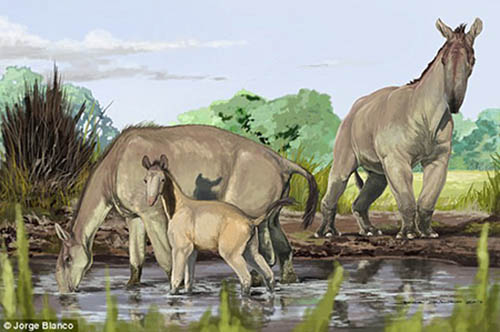
For the first time, scientists have recovered ancient DNA from one of the more puzzling species to have lived during the last Ice Age, a creature named Macrauchenia patachonica. The DNA allows researchers to finally map the mammal's relationships and place it within a group that includes horses, rhinos, and tapirs. One of the last 'South American native ungulates,' or SANUs, this animal likely weighed as much as 500 kilograms (1,100lbs) and had baffled biologists, including its discoverer Charles Darwin, for more than 180 years.
10,000-Year-Old Remains of Extinct Woolly Rhino Baby Discovered Live Science - March 11, 2015
The remains of a baby woolly rhino that roamed the Earth at least 10,000 years ago have been discovered in a frozen riverbank in Siberia, researchers said. The rhino calf, nicknamed "Sasha" after the hunter and businessman who found it, is the only complete young specimen of the extinct species ever found, according to scientists at the Yakutian Academy of Sciences in Russia, to whom the creature was donated for study. The researchers hope to extract DNA from the specimen to determine its placement on the mammal family tree.
Prehistoric rhino reveals secrets BBC - December 6, 2012
The preserved body of a woolly rhinoceros has revealed new insights into how this now extinct giant animal once lived. The woolly rhino was once one of the most abundant large mammals living in Eurasia, but only a handful of preserved carcasses have been found.
Rhino 'Cooked to Death' 9 Million Years Ago, Fossil Reveals Live Science - November 27, 2012
About 9.2 million years ago, a teenage two-horned rhinoceros was literally cooked to death when a Mt. Vesuvius-like eruption enveloped it in lava reaching more than 750 degrees Fahrenheit (400 degrees Celsius), scientists say. The perhaps fortunate result: a well-preserved skull of the Rhinocerotid, with a tale to tell. An analysis of the volcanic rock-preserved skull suggests the animal's grisly death was near instantaneous. The flow of volcanic ash carried the detached skull about 19 miles (30 kilometers) north of the eruption site to the site where it was discovered in Cappadocia in Central Turkey.
Tibet Was Cradle of Evolution for Pre-Ice Age Giants Live Science - September 1, 2011
High on the Tibetan Plateau, paleontologists have uncovered the skull of a previously unknown species of ancient rhino, a woolly furred animal that came equipped with a built-in snow shovel on its face. This curiosity, a flat, paddle-like horn that would have allowed it to brush away snow and find vegetation beneath, suggests the woolly rhinoceros was well-adapted for a cold, icy life in the Himalayas about 1 million years before the Ice Age. Those adaptations may have left the rhino perfectly poised to spread across Asia when global temperatures plummeted, ushering in the Ice Age.
'Oldest' woolly rhino discovered BBC - September 1, 2011
A woolly rhino fossil dug up on the Tibetan Plateau is believed to be the oldest specimen of its kind yet found. The creature lived some 3.6 million years ago - long before similar beasts roamed northern Asia and Europe in the ice ages that gripped those regions. The discovery team says the existence of this ancient rhino supports the idea that the frosty Tibetan foothills of the Himalayas were the evolutionary cradle for these later animals.
Ice-Age rhinoceros remains found BBC - November 5, 2008
The remains of an Ice Age rhinoceros have been unearthed by a five-year-old girl at a Gloucestershire water park. Emelia Fawbert found the fossilized carcass at the Cotswold Water Park near Cirencester during a fossil hunt. Emelia and her father James, 33, from Bussage, near Stroud, dug up the atlas vertebra of the woolly rhino which roamed the area about 50,000 years ago. Emelia was among a group of fossil hunters searching a freshly-excavated gravel pit at the park on 26 October.
The atlas vertebra, which once supported the head of the animal had been sticking up through the clay which was exposed by the gravel excavations. The pair used a trowel to dig the bone from the mud. It has now been sealed in a special protective covering before being donated to a museum. The hunt, involving 75 people, also unearthed the leg bone and vertebra from an Ice Age deer and belemnites, the remains of squid-like creatures from the Jurassic period, some 150m years ago. Emelia, who wants to become a paleontologist, had joined the fossil hunt for the first time. It was organized by the Cotswold Water Park Society and led by Swindon paleontologist Dr Neville Hollingworth who also found the remains of a woolly rhinoceros in a gravel pit near Swindon in 2004.
Woolly rhino's ancient migration BBC - November 18, 2008
Paleontologists have pieced together the fossilized skull of the oldest example yet found of a woolly rhinoceros in Europe. The 460,000-year-old skull, which was found in Germany, had to be reconstructed from 53 fragments. The extinct mammals reached a length of three-and-a-half metres in adulthood and, unlike their modern relatives, were covered in shaggy hair.
Woolly Rhinoceros Discovery Is Oldest in Europe Live Science - November 12, 2008
A woolly rhinoceros was just 12 years old when it died in a pool of meltwater flowing off an inland glacier in Germany. That was 460,000 years ago. Now, scientists have pieced together the skull of this extinct mega-mammal and found it to be the oldest woolly rhinoceros in Europe. The skull was discovered more than a century ago in a gravel pit at the foot of the KyffhŠuser range, near Bad Frankenhausen (a town in Germany), but it was broken into more than 50 fragments. "This is the oldest woolly rhinoceros found in Europe, and it gives us a precise date for the first appearance of cold-climate animals spreading throughout Asia and Europe during the ice ages," said researcher Ralf-Dietrich Kahlke, a paleontologist at the Frankfurt Senckenberg Research Institute.
'Extraordinary' woolly rhino finds BBC - October 30, 2002
The remains of four woolly rhinos have been unearthed in an English quarry. Scientists describe the group find at Whitemoor Haye in Staffordshire as "extraordinary" and one of the best Ice Age discoveries of its type in Northern Europe in recent years. In addition to the great beasts, researchers have also dug out a remarkable range of superbly preserved plants and insects. One of the rhinos even has plant material still stuck to its teeth, giving possible clues to its last meal. Taken together, the specimens should enable archaeologists to build up a detailed picture of what life was like in this particular corner of the UK 30-50,000 years ago.
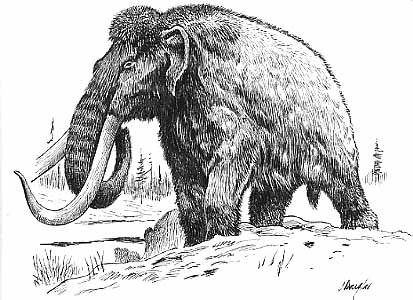
Woolly Mammoth
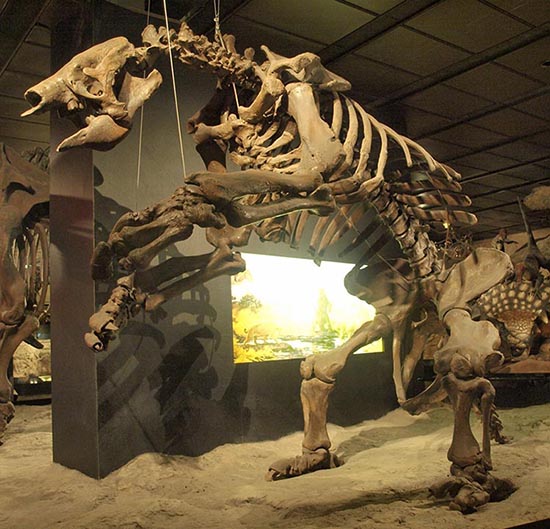
THEORY OF CRUSTAL DISPLACEMENT